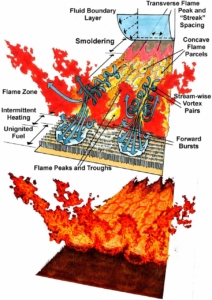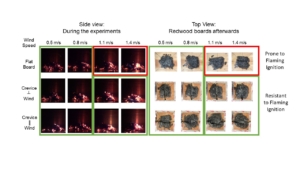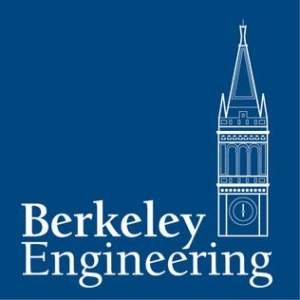Research
Our work focuses on understanding the physical processes controlling wildfires and other complex thermal-fluid phenomena. We primarily use experiments to investigate problems such as how fires spread, how emissions from fires are generated, and how buildings ignite, with the goal of reducing their devastating effects in the future. The study of fire is complex and multidisciplinary, therefore we use a wide variety of approaches partnering with collaborators specializing in numerical simulations, data science, ecology, forestry, remote sensing, and atmospheric science. Coupling experimental knowledge with simulations, scaling laws and theory helps to widen its application and implementation.
 Wildfires are devastating conflagrations that defy the imagination of nature’s fury. Researchers have struggled to describe wildfires for decades, yet such a complicated phenomenon requires continued study to understand the many physical aspects of fire and its impacts on people and the environment. We apply fundamental combustion physics to the problem of wildfires in an attempt to describe these fires piece by piece. The effect of discrete fuels, flammability of mixed fuels, flame spread on slopes and many more problems are of interest. Collaboration with wildfire modeling groups integrating sensor networks, fire weather, and more provides a new avenue to spread and apply our work.
Wildfires are devastating conflagrations that defy the imagination of nature’s fury. Researchers have struggled to describe wildfires for decades, yet such a complicated phenomenon requires continued study to understand the many physical aspects of fire and its impacts on people and the environment. We apply fundamental combustion physics to the problem of wildfires in an attempt to describe these fires piece by piece. The effect of discrete fuels, flammability of mixed fuels, flame spread on slopes and many more problems are of interest. Collaboration with wildfire modeling groups integrating sensor networks, fire weather, and more provides a new avenue to spread and apply our work.
One major avenue of work is to develop the next generation of wildfire spread models, in collaboration with the USFS Missoula Fire Science Laboratory. We published a major development in the Proceedings of the National Academy of Sciences which details how wildland fires do not spread steadily as a line, but rather form complex structures that change the way heat is moved forward to drive fire spread.
Prof. Gollner was the PI of WUI MAPR, an NSF-funded project that incorporates both data assimilation and modeling of fires as they spread from wildland fuels into the WUI. We collaborate with Reax Engineering to investigate past fires, their relationship to home destruction, and new methods to improve near-term wildfire forecasts.
We are also collaborators on the California Energy Commission project Pyregence to build the next generation of wildland fire models. Our role includes the development of models for large downed woody fuels which smolder long after a fire front passes.
 Wildland fires which burn into developed areas, known as the Wildland-Urban Interface (WUI), have resulted in numerous large-scale disasters over the last few years. In Northern California the 2017 Tubbs fire was particularly destructive, burning over 5,000 structures and resulting in over 43 deaths. The majority of structures were ignited by small wooden smoldering particles, called embers, rather than the flame front of the wildland fire. Embers are generated in huge quantities in large wildland fires and then lofted several meters to kilometers ahead of the flame front. There they rain down on structures and accumulate in crevices, corners, and gaps as piles. Under the right conditions, these piles become sufficiently hot to create a flame and ignite the structure. It is unknown what these right conditions are, which hinders the strive to increase the fire resistance of the Wildland-Urban interface. One major project funded by NIST is investigating the conditions under which ember piles ignite real structures to facilitate the development of a more resistant Wildland-Urban Interface. We use laboratory scale experiments to unravel the fundamental physics behind the ignition of structures by ember piles. We also have worked to understand the processes that generate embers from different fuels. Another current project funded by NSF is tackling the modeling of fire spread within the WUI, lacking in current models. Together with industry and government bodies, we translate this knowledge into practical guidance for local government, homeowners, and insurance companies so that tomorrow’s buildings in the WUI are safer.
Wildland fires which burn into developed areas, known as the Wildland-Urban Interface (WUI), have resulted in numerous large-scale disasters over the last few years. In Northern California the 2017 Tubbs fire was particularly destructive, burning over 5,000 structures and resulting in over 43 deaths. The majority of structures were ignited by small wooden smoldering particles, called embers, rather than the flame front of the wildland fire. Embers are generated in huge quantities in large wildland fires and then lofted several meters to kilometers ahead of the flame front. There they rain down on structures and accumulate in crevices, corners, and gaps as piles. Under the right conditions, these piles become sufficiently hot to create a flame and ignite the structure. It is unknown what these right conditions are, which hinders the strive to increase the fire resistance of the Wildland-Urban interface. One major project funded by NIST is investigating the conditions under which ember piles ignite real structures to facilitate the development of a more resistant Wildland-Urban Interface. We use laboratory scale experiments to unravel the fundamental physics behind the ignition of structures by ember piles. We also have worked to understand the processes that generate embers from different fuels. Another current project funded by NSF is tackling the modeling of fire spread within the WUI, lacking in current models. Together with industry and government bodies, we translate this knowledge into practical guidance for local government, homeowners, and insurance companies so that tomorrow’s buildings in the WUI are safer.
 Fire whirls represent a general class of flows that may be considered slender vortices involving buoyant momentum from heat release and tangential momentum from air entrainment. These structures are observed frequently in wildland fires and have been studied for many decades in the context of fire spread and firefighter safety. The Berkeley Fire Research Laboratory is interested in various aspects of fire whirl behavior including the prediction of the conditions required for their formation, their fluid dynamic properties, behavior under microgravity, and their use for reducing combustion-generated emissions. One regime of recent interest in academia is the blue whirl, which was discovered by Drs. Gollner and Oran at the University of Maryland. The blue whirl is a soot-free flame that can form directly over a small pool of liquid hydrocarbon fuel. Research in these areas is approached from an experimental standpoint coupled with scaling theory to understand the blue whirl, emissions from fire whirs, and other fundamental questions.
Fire whirls represent a general class of flows that may be considered slender vortices involving buoyant momentum from heat release and tangential momentum from air entrainment. These structures are observed frequently in wildland fires and have been studied for many decades in the context of fire spread and firefighter safety. The Berkeley Fire Research Laboratory is interested in various aspects of fire whirl behavior including the prediction of the conditions required for their formation, their fluid dynamic properties, behavior under microgravity, and their use for reducing combustion-generated emissions. One regime of recent interest in academia is the blue whirl, which was discovered by Drs. Gollner and Oran at the University of Maryland. The blue whirl is a soot-free flame that can form directly over a small pool of liquid hydrocarbon fuel. Research in these areas is approached from an experimental standpoint coupled with scaling theory to understand the blue whirl, emissions from fire whirs, and other fundamental questions.
 Modeling the realistic burning behavior of condensed-phase fuels is challenging, in part because of an inability to
Modeling the realistic burning behavior of condensed-phase fuels is challenging, in part because of an inability to
resolve complex interactions at the interface between gas-phase flames and condensed-phase fuels. This interaction is even more complex as scales increase because realistic fires occur under fully turbulent conditions
which have yet to be fully replicated or understood at the bench scale, where detailed measurements can be conducted. Several projects explore the dynamic relationship between combustible condensed fuel surface and gas-phase flames in both laminar and turbulent boundary layers, representing the small scales in which materials are tested (where much of today’s theoretical knowledge is also isolated) to realistic large-scale turbulent flames present in almost all unwanted fires, hybrid rocket motors and other similar combustion
 Research on flame spread is essential to
Research on flame spread is essential to
understanding the risks associated with materials in a wide range of geometries. Our research into flame spread developed from warehouse fire research, where flame spread over corrugated cardboard and mixed commodities were studied. Most efforts are now devoted to problems related to wildland fires but fundamental work on forced-flow flames, slopes, configurations, and discrete fuels are under study.
Fire safety is a concern in space travel, particularly with the current plans to increase the length of manned space missions (e.g. missions to Mars), and of using spacecraft atmospheres different than in Earth, such as microgravity, low-velocity gas flows, low pressure, and elevated oxygen concentration. Prof. Gollner and students collaborate with Prof. Fernandez-Pello and the Combustion and Fire Processes Laboratory on both the MIST and SAFIRE projects investigating fire safety in microgravity.
We are interested in understanding emissions from wildland fires, both to understand effluents released into the environment and to understand health effects on firefighters and local populations. We have a custom-built linear tube-heater apparatus that produces steady-state wildland-fire like smoke. We also have a cone heater, a larger platform for fire spread studies, and the ability to develop custom apparatus. These tools allow us to study the gaseous and particulate emissions from a variety of wildland fuels under both flaming and smoldering combustion conditions. The goal is to better quantify the emissions by isolating the effect of fuel type, fuel moisture content, and the mode of combustion. Current work is a joint project with Northeastern University, where the experimental setup has been replicated and the mice are exposed to the smoke to understand the acute and chronic health effects of smoke on Wildland firefighters. This project is funded by DHS/FEMA Fire Prevention and Safety Grant program.





Dipanjan and Shashikala Deb
(Faculty Fellowship)








